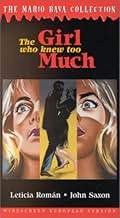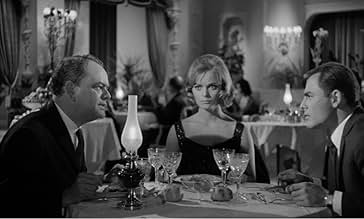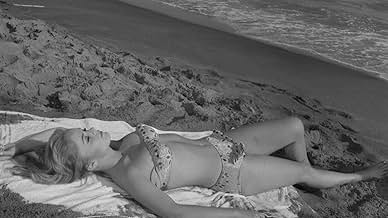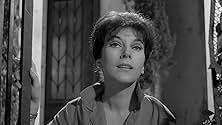En vacances à Rome, Nora Davis assiste impuissante à un meurtre. Personne ne croyant son témoignage, elle se met à accumuler les indices afin de prouver sa bonne foi. Ce jeu de piste la met ... Tout lireEn vacances à Rome, Nora Davis assiste impuissante à un meurtre. Personne ne croyant son témoignage, elle se met à accumuler les indices afin de prouver sa bonne foi. Ce jeu de piste la met sur la voie de la prochaine victime: elle-même.En vacances à Rome, Nora Davis assiste impuissante à un meurtre. Personne ne croyant son témoignage, elle se met à accumuler les indices afin de prouver sa bonne foi. Ce jeu de piste la met sur la voie de la prochaine victime: elle-même.
- Réalisation
- Scénario
- Casting principal
- Récompenses
- 1 victoire et 1 nomination au total
- Nora Davis
- (as Leticia Roman)
- …
- Dr. Alessi
- (as Robert Buchanan)
- Professor Torrani
- (as Gianni De Benedetto)
- Andrea Landini
- (as Dante Di Paolo)
- Uncle Augusto
- (non crédité)
- Asylum employee
- (non crédité)
- Woman in Sguattera Restaurant
- (non crédité)
Avis à la une
In the movie there is suspense , thriller , horror and results to be very exciting . The film is entertaining for continued tension , emotion , intrigue ; besides , appearing numerous palaces , famous buildings and squares that create spectacular scenarios . The picture is considered to be the first Giallo , being rightly regarded as the seminal work in what became known as the "Giallo" genre , a sub-genre invented by Mario Bava and successfully continued by Riccardo Freda and Dario Argento . Bava would follow filming Giallos as ¨Blood and black lace¨ and classics of horror cinema as ¨Mask of demon¨ , ¨Black Sabbath¨ and ¨Planet of vampires¨ . Film casting is frankly well . Leticia Roman as an enticing scream girl is enjoyable and attractive , John Saxon as her young friend is very fine and veteran Valentina Cortese is excellent . Robert Nicolosi's musical score is atmospheric , though in the US version is composed by Les Baxter , Corman factory's regular , and the catching opening song is sung by Adriano Calentano . Magnificent white and black cinematography by the same Mario Bava , as usual in most his movies , and this was his final black and white production . At the film is shown and well photographed several monuments and squares from Rome , such as : Foro Italico Stadium , Piazza Navona , Mincio Square , Colisseum , Piazza del Popolo and Piazza di Spagna . This motion picture which in some countries was released under the following titles : "The Evil Eye" , ¨Incubus¨ or ¨Obsession diabolique¨ will appeal to terror cinema fans and Giallo enthusiasts . Rating : Good . Well worth seeing
As the title suggests, The Girl Who Knew Too Much is indebted to Alfred Hitchcock more than anything else. The idea of an innocent thrust into the middle of a deadly situation is one Hitchcock used many times. While the romantic sub-plot and moments of light comedy also recall his work. These latter two elements are mainly what mark out TGWKTM as a cross-over film, as they are certainly not features of giallo cinema as it would develop. But the light, comic approach is one of the things that make this one of the most playful and upbeat films that Mario Bava ever made. Unlike his three other gialli, this film actually has sympathetic characters. While it doesn't have the melodramatic tendencies that those ensemble movies had either. The approach is much more restrained, with a fairly simple amateur sleuth narrative being the framework. Completely different too is the black and white aesthetic. Bava is of course rightfully famous for his masterful use of colour but in this film he shows that his use of light and contrast is just as impressive. This is a very handsome looking movie. Letícia Román adds to this aesthetic too of course, seeing as she is a very beautiful woman. Visually, this is a terrific film. Story-wise, it's certainly less interesting. The fairly mechanical plot is sufficient enough in taking us from A to B but it isn't particularly memorable. But it does introduce some of the motives that would go on to form an important part of giallo cinema such as the convoluted mystery, the bizarre reasoning for murder and the importance of optical subjectivity as well as the focus on style over substance.
The Girl Who Knew Too Much is a film that should be seen by fans of Mario Bava as well as dedicated students of all things giallo. It's a film that is as breezy and light as the genre ever got. It's a lovely and beautiful looking flick from a master film-maker.
This is no doubt the first giallo film and the last film Bava shot in black and white.
It is very mild when it comes to the gore n it aint scary but a bit comedic n predictable if u pay attention.
The movie plays more like a Hitchcockian thriller and it is obvious that this movie is one genius' homage to another genius.
I enjoyed this even more as i am a big fan of Saxon and his character is one of the suspect. The beach scene is hilarious.
The scene wher the priest picks up the cigarette laden with marijuana is epic.
Bava's cinematography is once again splendid.
The Piazza di Spagna n Spanish steps are captured very well.
Bava is so precise with the direction. After the murder there is rain, so one can't look for blood.
Also when the lead female is trying to recollect the murder n just when she is about to recollect the knife thrown by the killer, she is distracted by the gun shots (kid's toys) n she forgets.
P. S. In the Italian Version, Nora and Marcello are standing at an overlook, trying to forget what happened, planning their wedding. When Marcello wants to light a cigarette Nora got out of her purse, she starts thinking that it was all in her head as a result of smoking weed. She tosses the spliffs and a reverend picks them up. Now the word "FINE" appears on the screen.
In the US Version, a man with binoculars gets in a chair lift in order to shoot a woman. Nora and Marcello are in another chair lift and witness the entire thing. They are talking about getting married as well, but Marcello wishes that Nora would never ever start with any kind of crimes or murders.
Well, this is a classic worth watching for film buffs interested in the first giallo movie ever made (if we ignore the Hitchcock precedents). Giallo films are purposely simple and gory and filled with dramatic camera-work. In a sense they play off the style, one after another, becoming increasingly about the genre rather than movies that stand on their own. It's like slasher films these days, or maybe even zombie films, where you watch knowing what you're going to get, and that's exactly what you want.
Even the director, Mario Bava, admitted openly this was a silly film with great cinematography. That sums it up. He couldn't even remember the two leading actors. There is a bizarre, cheesy, low-budget thriller aspect to the whole enterprise that makes it fun in a campy way even if you aren't a giallo fan. But it's not good in a traditional sense.
Even the main premise is old as the hills--a serial killer is stabbing women in the back in alphabetical order by last name. This is oddly confused in the plot, because woman C was killed a decade before and we see the next woman killed before our eyes. But the heroine's last name begins with D, as if she is going to be next, and indeed she finds her picture in a file at the end suggesting she really is next in line. So what letter did the woman killed before our eyes have?
One of the weird aspects to the plot might explain this--the woman accidentally smokes a marijuana cigarette at the beginning of the movie, and we come to realize she might have dreamed the whole episode. Never mind there are other deaths and mishaps that seem rather real. And a handsome Italian doctor in love with her.
It's also weird in a funny way that the lead woman is an Italian actress playing an American visitor in Rome. Naturally her Italian is excellent. And the whole movie is centered around the Spanish Steps, which are often completely (completely) empty, not a person around. Adds to the surrealism. There are creaky horror film conventions like the shadowy man seen through the window, or the overdecorated house with creepy lights where the woman is staying, alone of course.
What's to recommend this? The photography. The noir influence (and the Roger Corman one, I suppose) is clear. And beautiful. Now if the story and acting made some modicum of sense we'd be set for a classic over-the-top scary movie. Yes, it's important as a giallo example, but don't overblow the result.
Bava in a rare instance uses naturalistic lighting. Usually the lighting in a Bava film is drenched in artful color. The only other film by Mario Bava to use naturalistic lighting is Rabid Dogs(1974). Lacks the sex and violence that dominates the gialli novels. The director was fascinated by the deception of appearences in this film and in his entire filmography. He seemed to have little optimism about human behavior or human nature. There are only three murders that occur in the film while the others happen before the story begins.
The Girl who Knew Too Much(1963) deals with Bava's favorite theme of greed. The murderer before being overcome with bloodlust does these deeds because of obsession with money. Greed is the seed of destruction for the characters in Blood & Black Lace(1964), A Bay of Blood(1971), and Rabid Dogs(1974). Part Alfred Hitchcock and part Edgar Wallace. The acting in the film is good. Leticia Roman is excellent as the naive and attractive Nora Davis. Mario Bava was not interested in doing the film but due to money reason directed it anyway.
Downplays the romantic subplot involving Nora Davis and Dr. Marcello Bassi. The scenes that uses suggestions of drug use were cut for the USA release. I love the scene where Nora sets up a booby trap to catch the murderer with disasterous results. The camera was in love with the figure of Leticia Roman during the scene at the beach while panning from her face to her feet. The short love scene between Nora and Marcello has a short spurt of eroticism. One of the writers who worked on the film was Django director, Sergio Corbucci. John Saxon does some fine acting as the leading man.
Mario Bava and John Saxon did not get along due to many misunderstandings during filming. The director it seems didn't think too highly of actors or actresses. Dante Dipaolo plays the newspaper reporter with sympathy. The use of the tape recorder by the murderer is cleaver. Valentina Cortese gets the top acting honors as the mysterious Laura Terrani. The discovery of the murderer is one of the film's main highlights. Impressed Dario Argento when he did The Bird with the Crystal Plumage(1969) and thus being responsible for the longevity and success of the Giallo in Italy.
Le saviez-vous
- AnecdotesMario Bava was a big fan of Alfred Hitchcock, and Hitchcockian touches abound in the film, including a cameo by the director. In the scene where Letícia Román is in her bedroom at Ethel's home, the portrait on the wall with the eyes that keep following her is that of Mario Bava.
- GaffesWhen Nora answers the phone in the Torrani house, "hello" is heard before she speaks, even while the receiver is being lifted to her mouth.
- Citations
Nora Davis: [into the phone] Oh mother, murders don't just happen like that here.
- Versions alternativesAIP released this as The Evil Eye, a recut version with material used just in some countries out of Italy.
- ConnexionsFeatured in Mario Bava: Maestro of the Macabre (2000)
- Bandes originalesFurore
(Appears in the Italian version)
Sung by Adriano Celentano
Written and Composed by Adriano Celentano (as Adicel) and Piero Vivarelli (as Vivarelli)
Published by Edizioni Nazionalmusic and Disco Jolly
Meilleurs choix
- How long is The Evil Eye?Alimenté par Alexa
Détails
- Date de sortie
- Pays d’origine
- Langues
- Aussi connu sous le nom de
- The Evil Eye
- Lieux de tournage
- Sociétés de production
- Voir plus de crédits d'entreprise sur IMDbPro
- Durée
- 1h 28min(88 min)
- Couleur
- Mixage
- Rapport de forme
- 1.66 : 1

















